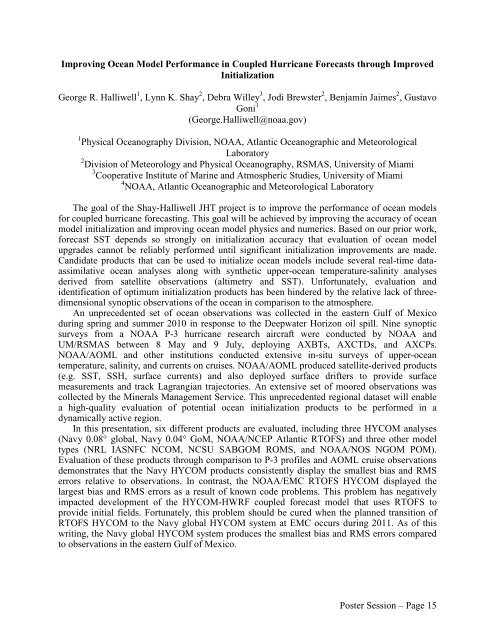65th IHC Booklet/Program (pdf - 4.9MB) - Office of the Federal ...
65th IHC Booklet/Program (pdf - 4.9MB) - Office of the Federal ...
65th IHC Booklet/Program (pdf - 4.9MB) - Office of the Federal ...
You also want an ePaper? Increase the reach of your titles
YUMPU automatically turns print PDFs into web optimized ePapers that Google loves.
Improving Ocean Model Performance in Coupled Hurricane Forecasts through Improved<br />
Initialization<br />
George R. Halliwell 1 , Lynn K. Shay 2 , Debra Willey 3 , Jodi Brewster 2 , Benjamin Jaimes 2 , Gustavo<br />
Goni 1<br />
(George.Halliwell@noaa.gov)<br />
1 Physical Oceanography Division, NOAA, Atlantic Oceanographic and Meteorological<br />
Laboratory<br />
2 Division <strong>of</strong> Meteorology and Physical Oceanography, RSMAS, University <strong>of</strong> Miami<br />
3 Cooperative Institute <strong>of</strong> Marine and Atmospheric Studies, University <strong>of</strong> Miami<br />
4 NOAA, Atlantic Oceanographic and Meteorological Laboratory<br />
The goal <strong>of</strong> <strong>the</strong> Shay-Halliwell JHT project is to improve <strong>the</strong> performance <strong>of</strong> ocean models<br />
for coupled hurricane forecasting. This goal will be achieved by improving <strong>the</strong> accuracy <strong>of</strong> ocean<br />
model initialization and improving ocean model physics and numerics. Based on our prior work,<br />
forecast SST depends so strongly on initialization accuracy that evaluation <strong>of</strong> ocean model<br />
upgrades cannot be reliably performed until significant initialization improvements are made.<br />
Candidate products that can be used to initialize ocean models include several real-time dataassimilative<br />
ocean analyses along with syn<strong>the</strong>tic upper-ocean temperature-salinity analyses<br />
derived from satellite observations (altimetry and SST). Unfortunately, evaluation and<br />
identification <strong>of</strong> optimum initialization products has been hindered by <strong>the</strong> relative lack <strong>of</strong> threedimensional<br />
synoptic observations <strong>of</strong> <strong>the</strong> ocean in comparison to <strong>the</strong> atmosphere.<br />
An unprecedented set <strong>of</strong> ocean observations was collected in <strong>the</strong> eastern Gulf <strong>of</strong> Mexico<br />
during spring and summer 2010 in response to <strong>the</strong> Deepwater Horizon oil spill. Nine synoptic<br />
surveys from a NOAA P-3 hurricane research aircraft were conducted by NOAA and<br />
UM/RSMAS between 8 May and 9 July, deploying AXBTs, AXCTDs, and AXCPs.<br />
NOAA/AOML and o<strong>the</strong>r institutions conducted extensive in-situ surveys <strong>of</strong> upper-ocean<br />
temperature, salinity, and currents on cruises. NOAA/AOML produced satellite-derived products<br />
(e.g. SST, SSH, surface currents) and also deployed surface drifters to provide surface<br />
measurements and track Lagrangian trajectories. An extensive set <strong>of</strong> moored observations was<br />
collected by <strong>the</strong> Minerals Management Service. This unprecedented regional dataset will enable<br />
a high-quality evaluation <strong>of</strong> potential ocean initialization products to be performed in a<br />
dynamically active region.<br />
In this presentation, six different products are evaluated, including three HYCOM analyses<br />
(Navy 0.08° global, Navy 0.04° GoM, NOAA/NCEP Atlantic RTOFS) and three o<strong>the</strong>r model<br />
types (NRL IASNFC NCOM, NCSU SABGOM ROMS, and NOAA/NOS NGOM POM).<br />
Evaluation <strong>of</strong> <strong>the</strong>se products through comparison to P-3 pr<strong>of</strong>iles and AOML cruise observations<br />
demonstrates that <strong>the</strong> Navy HYCOM products consistently display <strong>the</strong> smallest bias and RMS<br />
errors relative to observations. In contrast, <strong>the</strong> NOAA/EMC RTOFS HYCOM displayed <strong>the</strong><br />
largest bias and RMS errors as a result <strong>of</strong> known code problems. This problem has negatively<br />
impacted development <strong>of</strong> <strong>the</strong> HYCOM-HWRF coupled forecast model that uses RTOFS to<br />
provide initial fields. Fortunately, this problem should be cured when <strong>the</strong> planned transition <strong>of</strong><br />
RTOFS HYCOM to <strong>the</strong> Navy global HYCOM system at EMC occurs during 2011. As <strong>of</strong> this<br />
writing, <strong>the</strong> Navy global HYCOM system produces <strong>the</strong> smallest bias and RMS errors compared<br />
to observations in <strong>the</strong> eastern Gulf <strong>of</strong> Mexico.<br />
Poster Session – Page 15
















